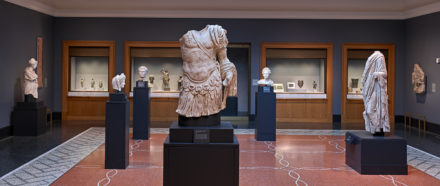Where is the line between private and public? Each situation has a different answer—and sometimes many different possible answers. As an example, take this painting by Henri de Toulouse-Lautrec.

The Model Resting, Henri de Toulouse-Lautrec, 1889. Tempera or casein with oil on cardboard, 25 5/8 x 19 3/8 in. The J. Paul Getty Museum, 84.PC.39
Lautrec portrays a woman seen from above and behind as she sits in a chair. Her left arm and breast are bared. She gazes into the distance, but we cannot see her face. Our view is cropped and the room is cluttered.
Lautrec preferred to use performers rather than professional models, and he painted prostitutes a number of times. The scattered clothes and bare breast suggest that this painting depicts a prostitute—but there are many open questions. Did Lautrec pose the woman in his studio? Did he work in the model’s room? Or is this a public setting, as suggested by the rows of tables and chairs?
If Lautrec hired this woman to sit for him, she would have been aware of his presence. Yet he creates tension in the composition by suggesting that she is oblivious to us, the viewers. Since her face is not visible, her privacy is preserved. But at the same time, our gaze becomes one of domination. Are we also a client?
In late 1800s Paris, prostitution was common, but the business of sex wasn’t discussed in polite circles. Lautrec made this private trade public by portraying its practitioners in his art.

A private moment made public?
Lautrec’s life, too, blurred the line between public and private. Though he inhabited the world of Montmartre bars and brothels and courted the image of the Bohemian, he dinnered nearly every night with his mother, a wealthy aristocrat and staunchly conservative Catholic, at her apartment on the respectable rue de Douai. He only made part of his private life public.
Lautrec was prolific, especially given that he died just before turning 37. He made over 700 paintings and 4,700 posters, lithographs, and drawings. Many of these portray women in a range of moods and situations. Yet privately he was unable to be emotionally intimate with women; though he had sexual relationships, none seem to have lasted very long.
Art can be made in the privacy of a studio, but the act of creating and recording something opens it to a potentially infinite public, extending into future generations.
In the age of blogging, Twitter, and Facebook, do any experiences remain truly private? What do we choose to reveal about ourselves, and what do other people share about us, with or without our knowledge?
Where is your line between your public and private selves?
Question of the Week is a series inspired by our Masterpiece of the Week tours. Featuring an open and upbeat discussion among visitors and gallery teachers, the tours feature a new object and pose a new question each week. Lautrec’s Model Resting is the object for the week of September 27, 2011.




I had always seen this painting as a very intimate portrait. But after reading your post, Alice, I now feel that the angle of view (from above, as if we’re inspecting the merchandise) does indeed suggest mastery or domination.
I also notice that while the model’s breast is theatrically spotlit, a technique you see in Lautrec’s paintings of stage performers, her neck and the outline of her cheek recede into colored shadows. So to answer your question, maybe in this woman’s case the answer to “Where is the line between private and public?” is, “the neck.”
Thank you, Annelisa, for pointing out this detail. Her body is in the public light but her mind is hidden and remains her own. This interpretation is reinforced by our view of the back of her head, which keeps her identity private.
Your comment also serves as a reminder that a profession, whatever it may be, is only part of a person’s life and doesn’t define his or her character.
Is Lautrec really making this private moment public? Or is he simply reinforcing the de facto invisibility of women in society? I agree that by obscuring the woman’s face, he makes us party to his male gaze. But is the effect of this approach benign, or even beneficial, as suggested by the assertion that he “preserves her privacy”? Or does it do something more destructive by presuming to invite the world into her boudoir?
Susan, you’ve picked up on a powerful tension in the painting. Lautrec’s point of view isn’t straightforward and can be interpreted as matter-of-fact, voyeuristic or respectful. Some critics write that Lautrec avoided constructing moral hierarchies in his work while others say his compositions revealed the superficiality of Parisian entertainments. I think the subtlety and ambiguity in “The Model Resting” render it captivating.
Profile pictures on the Web are often asymmetrical or slightly obscure compositions, maybe for anonymity or to try to be different. Since you brought up Facebook and Twitter and the notion of Web profiles, it made me think that perhaps Lautrec had a similar motive in this composition. As an artist, surely he wanted to stand out and try new ideas. With this perspective he does something unexpected and fresh, which makes the picture more interesting in a way.
On another note, “dinnered”? Is that really a verb?